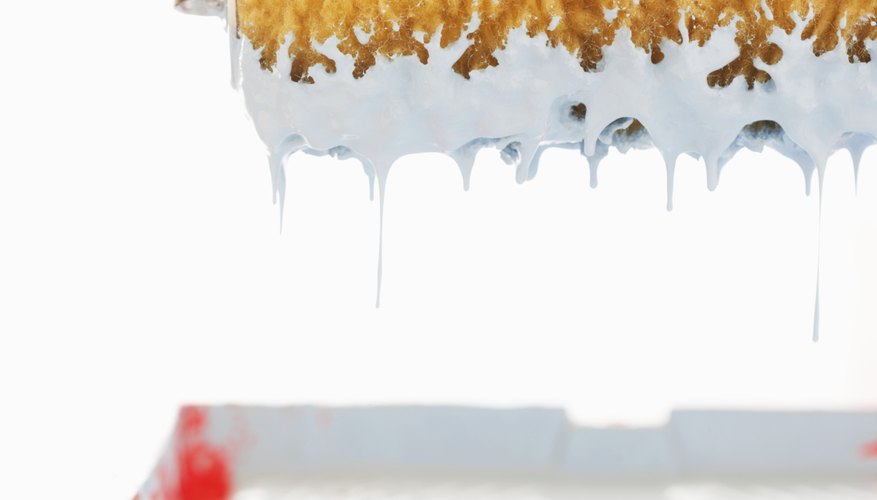Eggshell paint has a smooth, high-sheen finish similar to the shell of an actual egg. With durability and light-reflective qualities, you can use eggshell paint on walls or for trim, but it is also useful for renovating old wooden furniture. The finish is often considered more contemporary than gloss, but eggshell paint comes in a range of vintage-inspired colours to give your home a period touch. Using a little technical know-how and some professional tips can help prevent unsightly roller marks and achieve a smooth result.
Paint
Don’t just buy the first paint you come across, because the finish differs from brand to brand. Like gloss paint, eggshell also comes with an oil, acrylic or latex base. Acrylic paints dry quickly, so might appeal to home decorators, but without painting experience you risk ending up with an uneven finish and roller marks. Try out a few formulas and get comfortable with the feel of the paint by starting with tester pots and seeing how the finish dries.
- Don’t just buy the first paint you come across, because the finish differs from brand to brand.
- Acrylic paints dry quickly, so might appeal to home decorators, but without painting experience you risk ending up with an uneven finish and roller marks.
Preparation
Prepare the painting surface as smoothly as possible for a classic eggshell finish. Preparation typically involves removing debris, sanding the surface down and filling any holes. Sand the surface again with a coarse paper to take off lumps, bumps or any texture that might catch the roller and leave marks. Give a perfectly smooth key to the surface by finishing it with fine sandpaper.
- Prepare the painting surface as smoothly as possible for a classic eggshell finish.
- Give a perfectly smooth key to the surface by finishing it with fine sandpaper.
Priming
Prime to suit your surface but also the type of paint. For example, if you use an oil-based primer and then put acrylic eggshell on top, the paint may not adhere properly and you’ll inevitably see streaky roller marks. Gently dust the fine sandpaper over the dry, primed surface so that it is perfectly smooth.
Rollers
Fine, smooth rollers are typically the best for painting eggshell. The nap, which refers to the material of the roller covering, should be a maximum of 0.25 inches in depth, but you may go even finer. Also consider the surface you are painting. A smooth surface needs a smooth roller. Polyester foam rollers are ideal for creating the delicate eggshell finish, because they take up an even amount of paint without the extra texture caused by a fluffy pile.
- Fine, smooth rollers are typically the best for painting eggshell.
Painting
Don’t submerge your roller in paint and go straight to the wall. Remove fluff from a brand new roller with masking tape, and then rinse it through and squeeze it out. Before your first section, work a little paint in to the roller, then roll it out on a piece of card or wood. Paint quickly and apply even pressure. Do not press the roller in to the wall in an attempt to get all the paint out, because this causes ridges and streaks. Once you’ve painted an area with a full load, draw the roller back along the painted section. If you painted vertically, draw it back horizontally. This creates a perfect, smooth application with no marks. You can then reload your roller and go to the next patch. Continue until you've painted the whole area in the same way. Never take a break part way through painting a wall or surface, because the paint starts to dry at different times and you’ll inevitably get roller marks.
- Don’t submerge your roller in paint and go straight to the wall.
- Before your first section, work a little paint in to the roller, then roll it out on a piece of card or wood.
Tips
Use mini-foam rollers if painting small areas. Or if you still find this messy, use a brush. Try a soft and smooth brush for acrylic-based paint, and a natural bristle brush for oil-based eggshell. You can also brush a border around the outside of a wall, and then fill in the middle with a roller. This professional technique ensures a neat job that doesn’t reveal roller marks at the edge.
- Use mini-foam rollers if painting small areas.
- This professional technique ensures a neat job that doesn’t reveal roller marks at the edge.
